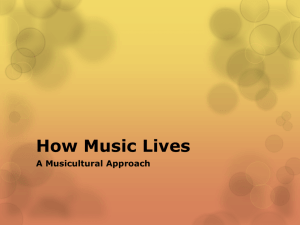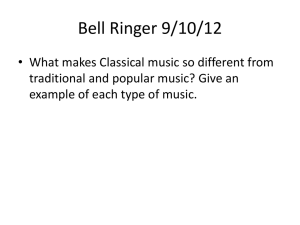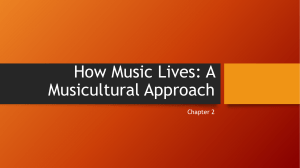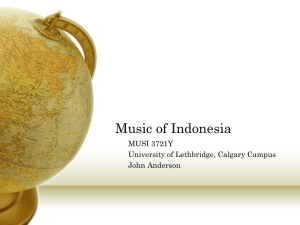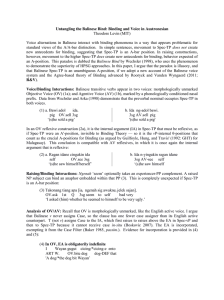030—Preparing for the Final—Fall 2005
advertisement
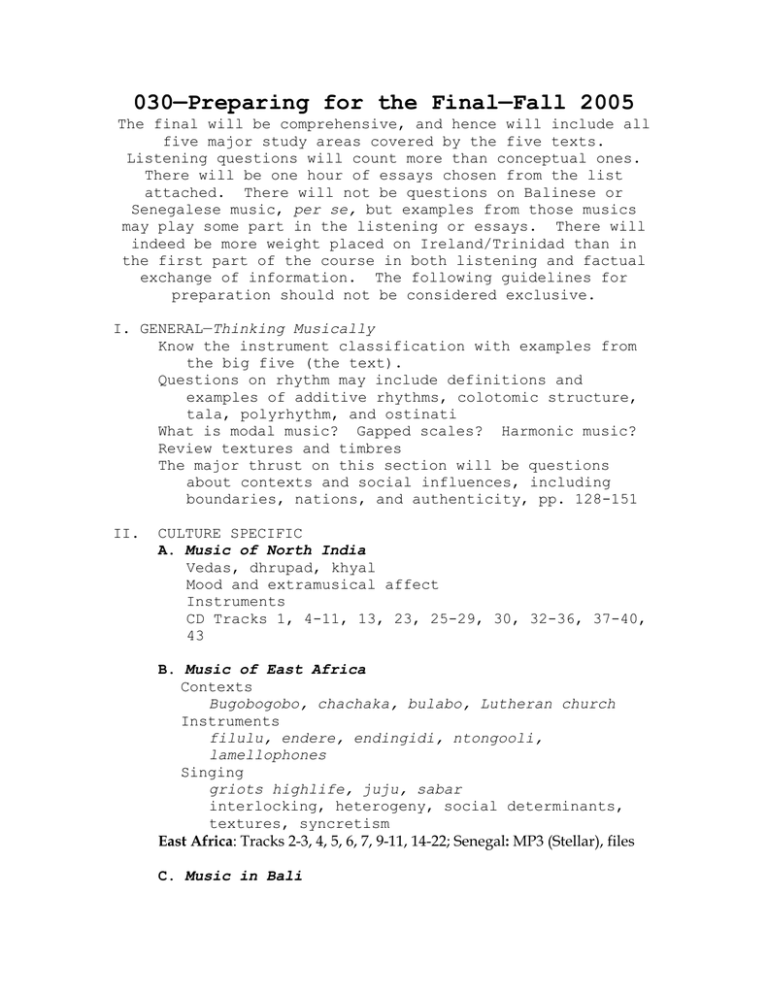
030—Preparing for the Final—Fall 2005 The final will be comprehensive, and hence will include all five major study areas covered by the five texts. Listening questions will count more than conceptual ones. There will be one hour of essays chosen from the list attached. There will not be questions on Balinese or Senegalese music, per se, but examples from those musics may play some part in the listening or essays. There will indeed be more weight placed on Ireland/Trinidad than in the first part of the course in both listening and factual exchange of information. The following guidelines for preparation should not be considered exclusive. I. GENERAL—Thinking Musically Know the instrument classification with examples from the big five (the text). Questions on rhythm may include definitions and examples of additive rhythms, colotomic structure, tala, polyrhythm, and ostinati What is modal music? Gapped scales? Harmonic music? Review textures and timbres The major thrust on this section will be questions about contexts and social influences, including boundaries, nations, and authenticity, pp. 128-151 II. CULTURE SPECIFIC A. Music of North India Vedas, dhrupad, khyal Mood and extramusical affect Instruments CD Tracks 1, 4-11, 13, 23, 25-29, 30, 32-36, 37-40, 43 B. Music of East Africa Contexts Bugobogobo, chachaka, bulabo, Lutheran church Instruments filulu, endere, endingidi, ntongooli, lamellophones Singing griots highlife, juju, sabar interlocking, heterogeny, social determinants, textures, syncretism East Africa: Tracks 2-3, 4, 5, 6, 7, 9-11, 14-22; Senegal: MP3 (Stellar), files C. Music in Bali Wali, bebali, balih-balihan odalan, ramé, gong kebyar, kotekan, wayang, kechak What is the sugnficance of number in the Balinese calendar? What does gamelan mean? What is the mythic origin? Name the important instruments of the Gong Kebyar gamelan. CD Tracks 8, 11, 12, 18-19, 21, 30-3239-40 D. Carnival Music of Trinidad Which ethnic groups comprise the society of Trinidad? What is their relative importance in the musical output of the island(s)? What social and political factors are to be considered in the formation of calypso? What are the instruments of early calypso, and which ones found their way into later calypso? (pp. 4144) What is kalenda and camboulay, and what is a chantwell (p. 24-25)? What are the characteristics of tamboo bamboo? p. 21 Who were the Iron Duke, Lorn Kitchener, The Mighty Sparrow, The Mighty Chalkdust, David Rudder, and Singing Sandra? What is the early history of pan, what were the main instruments, and what is the connection with European classical music (including instrument names)? What is the structure and significance of Pan in A Minor? What is Panorama, and what is its significance to pan? CD Tracks 4, 5-10, 12-15 Essays — Write three short essays (about 15 minutes each) choosing your topic from one question each in A and B and C. Write in the “blue book.” A. Music on the move (answer one only). 1. We have discussed several migrations of music in this course, and you have written on some of them in your personal projects. Choose one and note how the music changed and how it may have stayed the same. What are the factors in the dynamics of these processes? How does this example illustrate (or not) the anthropological axiom that the central values of a culture are often found at its perimeter? 2. Today’s “world-beat” music is largely syncretic. Using examples from Africa or India, discuss this phenomenon. 3. What is the authenticity factor in music, and how does it apply to what we have done in this class? B. Music as category (answer one only). examples wherever possible. 1. In what sense is the gong kebyar representative of the aesthetics Balinese it so successfully transplanted itself to Cite musical gamelan society? Why has the West? 2. Using the famous Titon model, discuss the pan ensemble of Trinidad, noting the ironies of its traditional position on the calendar. 3. Sacred and secular. Using Indian or Balinese music, discuss how the music that we looked at might be interpreted as sacred or secular. Are the categories meaningful outside that culture? Have they changed in time? 4. How does the music of East Africa satisfy the categories of music as listed in class. C. Music in my opinion (answer one only). 1. World popular music shows ever-increasing similarities, which include sound, rhythm, text, length, simplicity, and audience. Some people despair, some rejoice. Some turn away. Some dance. What is your feeling? 2. Was Isaac Stern’s insistence on using another piano in the Shanghai concert merited, given the nuisance he was causing to the organizers? 3. "Strictly speaking, music cannot be taught. It is up to the teacher to place the student in a musical environment, but the actual learning process is entirely up to the student. " So said a shakuhachi master. What has this got to do with what your experience in this course has been? 4. "If this is Tuesday, it must be Belgium." So runs the famous jibe (folklore) about travel tours. The implication is that the saturation of continual change dulls the experience. What has this got to do with learning world music, and what has been your experience with this course? 5. Cheese. Dorky. Each generation finds the pop music of previous generations to be somewhat “cheesy.” Using the music of your parents’ generation, discuss what this factor is and why it inhibits communication across musical styles. Does it also work across cultures? How? I have neither received nor given aid, nor have I used crib sheets in taking this exam, nor will I discuss it until after the exam period. signed




